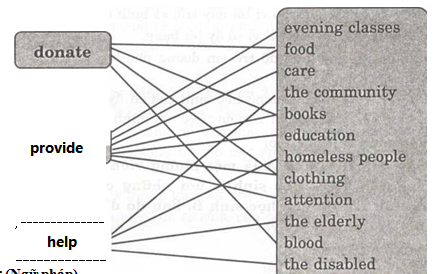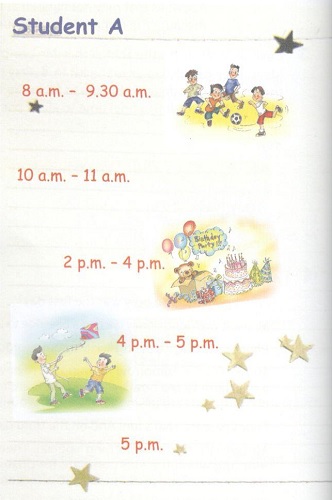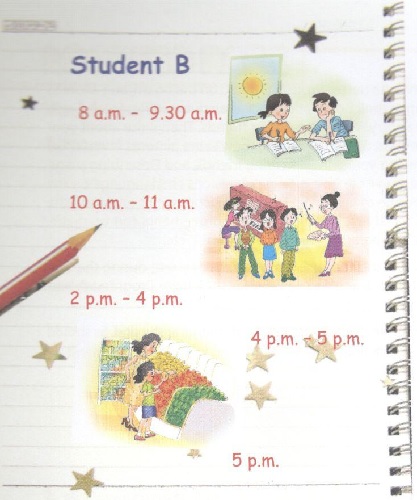soan tiếng anh lớp 7 sách mới unit 3 bài looking back

Những câu hỏi liên quan
Có ai hok sách Tiếng Anh 6 mới ko giúp mk phần looking back unit 3 với
1. Match the verbs in blue with the correct words in the box (Nối những động từ màu xanh với những từ đúng trong khung.)

2. Circle the best answer. (Khoanh tròn câu trả lời hay nhất)
1. Because Minh has (ever, never, ago) worked for a charity shop, he really wants to do it.
2. (Already, Last week, So far) we visited sick children in Viet Due Hospital.
3. Nhung has (already, many times, ever) finished all the homework.
4. Have you read that book (yet, ever, never)?
5. Yes, I finished it (three times, so far, yesterday).
1. never 2. last week 3. already 4. yet 5. yesterday
1. Bởi vì Minh chưa từng làm việc cho một cửa hàng từ thiện, nên anh ấy thực sự muốn làm.
2. Tuần rồi chúng tôi đã thăm trẻ em bị bệnh ở Bệnh viện Việt Đức.
3. Nhung vừa hoàn thành tất cả bài tập về nhà.
4. Bạn đã đọc cuốn sách đó chưa?
5. Vâng, tôi đã hoàn thành nó hôm qua.
3. Put the verbs in the past simple or the present perfect. (Đặt động từ thành thì quá khứ đơn hoặc hiện tại đơn.)
1. He thinks she's the most kind-hearted girl he...........ever (meet) .
2. She (visit)_________ Hue when she was a child.
3. She (visit)__________ Hue once.
4. How many plays________ Shakespeare (write)_______ ?
5. How many plays________________ she (write)__________ so far?
1. has ever met 2. visited 3. has visited
4. did Shakespeare write 5. has she written
1. Anh ấy nghĩ cô ấy là cô gái tốt bụng nhất mà anh ấy từng gặp.
2. Cô ấy đã thăm Huế khi cô ấy còn nhỏ.
3. Cô ấy đã thăm Huế một lần.
4. Shakespeare đã viết bao nhiêu vở kịch?
5. Cho đến giờ cô ấy đã viết bao nhiêu vở kịch?
4. Finish the sentences below. (Hoàn thành các câu bên dưới.)
1. the engine is very good
2. it is going to be cold this evening
3. she’s kind
4. they are not as lucky as we are
5. she works very hard to improve her teaching
1. Họ đã quyết định mua xe hơi đó vì động cơ rất tốt.
2. Mặc áo khoác ấm vào vì tối nay trời sẽ lạnh đó.
3. Anh ấy thích cô ấy bởi vì cô ấy tốt bụng.
4. Chúng ta hãy giúp đỡ trẻ em đường phô" bởi vì trẻ không may như chúng ta.
5. Bởi vì cô ấy yêu thương học sinh của cô ấy, nên cô ấy làm việc rất chăm chỉ để cải thiện việc dạy học của mình
5. Role-piay. Student A is a reporter and student B is a volunteer. Student A asks the questions and writes down student B's answers. Then swap your roles. Use the following questions as prompts: (Đóng vai. Học sinh A là một phóng viên và học sinh B là một tình nguyện viên. Học sinh A hỏi những câu hỏi và viết xuấng những câu trả lời của học sinh B. Sau đó đổi vai. Sử dụng những câu hỏi sau như là gợi ý:)
Student A (Học sinh A)
Bạn tham gia chương trình Phố số 6 của chúng tôi cách đây 6 tháng bởi vì bạn muốn giới thiệu văn hóa Việt Nam cho khách du lịch, và thực hành tiếng Anh. Bạn đã dẫn 4 tour bằng tiếng Anh, và giúp khách tham quan chơi những trò chơi của truyền thông Việt Nam. Tháng rồi, bạn cảm thấy hạnh phúc khi bạn nhận được một lá thư cảm ơn từ hai khách tham quan người úc vốn rất thích các tour
A: When did you start working for your organization, Our Town?
Bạn bắt đầu làm cho tổ chức của bạn, Phố chúng tôi từ khi nào?
B: I joined 6 months ago. Tôi đã tham gia cách đây 6 tháng.
A: Why did you decide to volunteer?
Tại sao bạn quyết định làm tình nguyện?
B: Because I wanted to introduce Vietnamese culture to foreigners, and to practice English.
Bởi vì tôi muốn giới thiệu văn hóa Việt Nam đến người nước ngoài, và thực hành tiếng Anh.
A: What have you done so far with Our Town?
Cho đến giờ bạn đã làm gì với Phố chúng tôi?
B: We’ve given tours in English, and helped visitors play traditional Vietnamese games.
Chúng tôi đã đem đến những tour du lịch bằng tiếng Anh, và giúp khách tham quan chơi những trò chơi truyền thống Việt Nam.
A: Was there anything that made you happy with your work last month?
Có điều gì làm bạn hạnh phúc với công việc của bạn vào tháng rồi không?
B: Last month we felt happy when we received a thank you letter from two Australian visitors who liked the tours very much.
Tháng rồi, chúng tôi cảm thấy hạnh phúc khi nhận được bức thư cảm ơn từ hai khách tham quan úc vốn rất thích tour.
Student B (Học sinh B)
Bạn đã tham gia chương trình Trái tim lớn 2 cách đây 2 năm bởi vì bạn muốn giúp người ta trong bệnh viện. Bạn đã hiến máu hai lần, và tặng quà cho trẻ em bị bệnh. Tháng rồi bạn cảm thấy vui khi bạn tự tay làm lồng đèn tết Trung thu và tặng nó cho một em gái nhỏ ở khách sạn vốn rất thích nó.
A: When did you start working for your organization, Big Heart 2?
Bạn đã bắt đầu làm việc cho tổ chức của bạn, Trái Tim Lớn 2 từ khi nào?
B: 2 years ago.
Cách đây 2 năm.
A: Why did you decide to volunteer?
Tại sao bạn quyết định làm tình nguyện?
B: Because I want to help people in hospital.
Bởi vì tôi muốn giúp mọi người trong bệnh viện.
A: What have you done so far with Big Heart 2?
Bạn đã làm gì với Trái Tim Lớn 2?
B: We donated blood twice, and given presents to sick children.
Chúng tôi đã hiến máu hai lần và tặng quà cho trẻ em bị bệnh.
A: Was there anything that made you happy with your work last month?
Có điều gì làm bạn hạnh phúc với công việc của bạn vào tháng rồi không? B: Last month we felt happy when we made a Mid-Autumn Festival lantern ourself and gave it to a little girl in hospital who loved it so much.
Tháng rồi chúng tôi cảm thấy hạnh phúc khi chúng tôi chúng tôi làm lồng đèn Trung thu và tặng cho một em gái nhỏ trong bệnh viện vốn rất thích nó.
Đúng 0
Bình luận (0)
1. Write the correct words on the faces.
creative boring funny confident hard-working kind clever talkative sporty shy patient serious
Can you remember more words? Add them to the faces.

Hướng dẫn:
Viết từ đúng trên khuôn mặt.
Smile face: creative, funny, confident, hardworking, kind, clever, talkative, sporty, patient
Sad face: boring, shy, serious
2. Make your own Haiku!
"Haiku" comes from Japan.
Write a three-line Haiku poem to describe yourself. The first and last lines have five syllables. The middle line has seven syllables. The lines don't need to rhyme.
My hair is shiny
My cheeks are round and rosy
This is me. I'm Trang!
Swap your Haiku with two friends. Don't write your name. Let them guess.
Hướng dẫn:
Em tự làm thơ haiku.
“Haiku” có nguồn gốc từ Nhật Bản.
Viết một bài thơ haiku gồm ba câu để miêu tả chính em. Câu đầu và câu cuối có 5 âm. Câu giữa có 7 âm. Các câu không cần theo nhịp.
My skin is so soft.
My eyes are black and very big.
This is me, I’m Nhung!
3. Game: Who's who?
In groups, choose a person in your group. Describe their appearance and personality. Let your friends guess.
Example:
Group: Who is it?
A: He's tall. He has glasses. He's talkative.
He's creative too. He isn't shy.
B: Is it Minh?
A: Yes!/No, try again.
Hướng dẫn:
Trò chơi: Ai là ai?
Trong các nhóm, chọn một người trong nhóm. Miêu tả ngoại hình và tính cách của họ. Hãy để bạn của em đoán.
Group (Nhóm): Who is it? Đó là ai?
A: He’s short. His hair is curly and black. He’s funny and serious. He
isn’t handsome. Anh ấy thấp. Tóc anh ấy quăn và đen. Anh ấy hài hước
và nghiêm túc. Anh ấy không đẹp trai.
B: Is it Nam? Nam phải không?
A: Yes. Phải.
4. Complete the dialogue.
A: What___________ you________tomorrow?
B: I__________ some friends. We.___________to Mai's birthday party. Would you like to come?
A: Oh, sorry, I can't. I______________ football.
B: No problem, how about Sunday? I__________ a film at the cinema.
A: Sounds great!
Hướng dẫn:
Hoàn thành bài đối thoạỉ
A: What are you doing tomorrow? Ngày mai bạn định làm gì?
B: I am going with some friends. We are going to Mai’s birthday party. Would you like to come? Mình sẽ đi cùng vài người bạn. Chúng mình sẽ dự bữa tiệc sinh nhật của Mai. Bạn đến nhé?
A: Oh, sorry. I can’t. I am playing football. Ô, xin lỗi. Mình định đi chơi bóng đá.
B: No problem, how about Sunday? I am watching film at the cinema. Không sao, còn Chủ nhật thì sao? Minh sẽ đến rạp chiếu bóng xem phim.
A: Sounds great! Được đó.
5. Student A looks at the schedule on this page. Student B looks at the schedule on the next page
Example:
A: What are you doing tomorrow?
B: I'm playing football with my friends./l'm not doing anything.


Hướng dẫn:
Học sinh A nhìn vào thời gian biểu ở trang này. Học sinh B nhìn
vào thời gian biểu trang kế tiếp.
Ví dụ:
A: Mai bạn sẽ làm gì?
B: Mình sẽ chơi bóng đá với bạn mìnhỆ/ Minh chẳng làm gì cả.
Học sinh A:
8 giờ sáng - 9 giờ 30 sáng: chơi bóng đá.
10 giờ sáng - 11 giờ sáng: nghỉ ngơi
2 giờ chiều — 4 giờ chiều: đi sinh nhật bạn
4 giờ chiều — 5 giờ chiều: chơi thả diều (play kite)
Học sinh B:
8 giờ sáng - 9 giờ 30 sáng: học bài cùng nhau 10 giờ sáng - 11 giờ sáng: học nhạc/ học hát
2 giờ chiều — 4 giờ chiều: học bài
giờ chiều - 5 giờ chiều: đi cửa hàng rau củ với mẹ
Đúng 0
Bình luận (0)
Bài 6 và bài 7.(Sách tiếng anh mới lớp 6, unit 1 trang 10)
mình cần gấp lắm nhé!
6.Choose the correct tense of the verbs
1.My family have/are having dinner now.
2.Mai wears/is wearing her uniform on Monday and Saturday.
3.The school year in Viet Nam starts/is staring on Sep 5th.
4.Now Duong watches/is watching Ice Age on video.
5.Look!The girls skip/are skipping in the schoolyard.
Minh chi nho cai nay thoi
Đúng 0
Bình luận (0)
mọi người ơi giúp mik làm phần này nhá
sách tiếng anh 7 tập 1 trang 25 unit 2 health lesson 7 looking back and project (làm phần project thôi nhé). mai mik nạp rồi cần gấp
hãy viết một bài văn bằng tiếng anh giới thiệu về việt nam từ gợi ý bài 3 looking back - unit 9 cities of the world.
Ok,..
I come from Vietnam. It's a small city, but it has many beautiful places. Here, the biggest city is Ho Chi Minh Ciy. It's large and very wonderful.![]() And the oldest university is Quoc Tu Giam university. It's near Van Mieu Quoc Tu Giam. In Vietnam, The most popular Vietnamese writer is Nguyen Du. He is very well. The most popular food is noodles:" Pho" with tea or coffee is the most popular drink. The most commom activity here is play sports. I love Vietnam a lot. I very very admire and love Vietnam- It's my hometown.
And the oldest university is Quoc Tu Giam university. It's near Van Mieu Quoc Tu Giam. In Vietnam, The most popular Vietnamese writer is Nguyen Du. He is very well. The most popular food is noodles:" Pho" with tea or coffee is the most popular drink. The most commom activity here is play sports. I love Vietnam a lot. I very very admire and love Vietnam- It's my hometown.
Like nha?![]()
Đúng 0
Bình luận (0)
I come from Vietnam. Do you know Vietnam? It's the country with a shape in Asia. There are many big cities in my country but Ho Chi Minh city is the biggest. Have you visited Quoc Tu Giam? That's the oldest university in my country and it's located in Hanoi - the capital of Vietnam. In term of culture, Nguyen Du and Ho Chi Minh are the most famous writers. Our country also has many types of food and drink. Noodle, spring roll and bread are the most popular food while tea, coffee and fruit juice are the most common drinks. We like watching TV and surfing Internet very much. Ah, we like playing football, too. Football is more popular than any other sports in our country.
Wish you good study ![]()
![]()
![]()
Đúng 0
Bình luận (0)
Unit 1: Leisure Activity
- Looking Back-
- Từ vựng mới của phần Looking Back Unit 1 Lớp 8 ( Vocalbary)
soạn giúp mình bài looking back trang 24 sgk tiếng anh mới 7 tập 1
vocabulary
Bài 1 là ngta cho mjh câu hỏi a, b, c, d rồi thì giờ mjh làm câu trả lời lun
A)you have a sunburn
B)you have a spots
C)you put on weight
D)you have a stomachache
E)you have a flu
Bài 2
1 spots
2 put on weight
3 sunburn
4 stomachache
5 flu
Bài 3
1.......less..........
2.......more........
3.......more.........
4......less.........
5 .....less.....
6.......more......
Bài 4
1I want to eat some junk food, but I am putting on weight
2) I don't want to be tired tomorrow, so I should go to bed early
3)I have a temperature, and I feel tired
4)I can ểcise every morning
Còn bài 5 bài 6 thì đọc thui có gì ko hiểu trog bài thì hỏi mjh nha
Tick cho mjh nha
Đúng 0
Bình luận (0)
Thay vì mấy bn soạn cho bn chép lại thì bn tự lm đại đại đi.Đỡ mất thời gian.
Đúng 0
Bình luận (2)
Soạn giúp mình bài skills 2 và looking back trang 23,24 sgk tiếng anh mới 7 tập 1
LESSON PLAN
Period 14: UNIT 2: HEALTH
Lesson 6: SKILLS 2
Date of preparation : September 13th, 2014
Date of teaching : September 15th, 2014
Classes : 7A1
I. Aims and Objectives:
+ Language content:
- To help students review some words about health.
- To help students listen to get specific information about health problems and advice, and
- To make them master how to write a reply giving advice to someone with a health problem.
+ Language function: To make students know how to give and write a reply giving advice to someone with a health problem.
+ Educational aim: To make students stay healthy.
II. Language Contents:
a- Vocabulary: Vocabulary: health problems
b- Structures: a paragraph
III. Techniques: pairwork, groupwork, individual work, question-answer, brainstorm
IV. Teaching aids: pictures, cassette, tape/ CD
V. Procedures:
1- Stabilization: (1m)
a- Warm up: Greeting.
b- Checking absence: Who’s absent today?
2- Checking up the previous knowledge: (5ms)
Questions:
Key:
Marks:
1. Write new words: chế độ ăn kiêng , chuyên gia ,giữ dáng , lời khuyên
2. Listen and answer the questions:
a. What is a calorie ?
b. Where do you get calories ?
c. What is a healthy number of calories per day ?
d. Which activity uses more calories : walking and sleeping ?
1. Write new words: diet, expert , stay in shape, tip
3. Listen and answer the questions: *Possible answers:
a. A calorie is energy that helps us do our daily activities
b. we get calories from the food we eat
c. between 1.600 to 2.500
d. walking
4ms
6ms
3- New lesson:
Time
Teaching steps
A.LISTENING:
1. Lead-in:
- Give them the Olympic rings and asks them what these represent.
- Brainstorms with Ss as a class different words that come to mind when Ss think of the Olympics.
- Introduces students to the new lesson.
2. Pre- Listening:
Activity 1: Look at the picture below. Discuss the following questions with partner.
- Asks students to have a look at picture and discuss.

3. While- Listening:
Activity 2: Listen to the interview with an ironman. Tick the problems he had as a child.
- Lets students listen twice.
- Asks students to answer (play the tape again) and check.
*Key: sick, allergy
Activity 3: Listen to the interview again. What advice does he give about preparing for event?
- Lets students listen again.
- Asks students to answer (play the tape again) and check.
*Key: Do more exercise, sleep more, eat more fruit/vegetables
Activity 4: Are the following sentences true (T) or false (F)?
- Asks students to do the task individually
- Calls some Ss to give their answers and corrects.
*Key:
1.T, 2. F, 3.F, 4.F, 5T
4. Post- Listening:
Activity 5: Discuss in groups.
- Asks students to discuss in groups about 2minutes.
- Calls some representatives represent their answers.
B. WRITING:
1. Lead-in:
- Gestures and says “ I have a headache. Can you give me an advice?”
- Introduces students to the new lesson.
2. Pre- writing:
- Explains: To give advice you can use:
+ You should….
+You can…
+ It will be good if you…
+Do something more/less…
3. While- writing
Activity 6: Look at Dr. Law’s advice page. Can you match the problems with the answers?
- Asks students to finish the task individually.
- Corrects and gives them the key
1. c, 2.b, 3a
4. Post- writing
Activity 6
-Has Ss work in pairs to do the task.
-Calls some pairs to share their problems and responses with the class.
5. Consolidation :
- Lets sts summarize the content of the lesson
6. Homework:
Grade 7: LESSON PLAN
Period 15: UNIT 2: HEALTH
Lesson 7: LOOKING BACK AND PROJECTS
Date of preparation : September 16th, 2014
Date of teaching : September 18th, 2014
Classes : 7A1
I. Aims and Objectives:
- To help the Ss review words relating to health.
- To help student review imperatives with more and less as well as compound sentences.
+ Language function: Students will be able to talk about health problems, give health advice..
+ Educational aim: To make students know how to stay healthy.
II. Language Contents:
a- Vocabulary: (review)
b- Structures: (review)
III. Techniques: pairwork, groupwork, individual work, question-answer
IV. Teaching aids: pictures, cassette, tape/ CD
V. Procedures:
1- Stabilization: (1m)
a- Warm up: Greeting.
b- Checking absence: Who’s absent today?
2- Checking up the previous knowledge: (5ms)
Questions:
Key:
Marks:
. Listen and answer the questions:
a. What will you do if you have flu?
b. I play computer games a lot and my eyes feel really dry. What should I do?
c. I have some spots. What can I do?
d. What do you do to have good health?
. Listen and answer the questions:
a. Drink more water./ Sleep more
b. You should try to rest your eyes.
c. You should wash your face more.
d. funny.
e. Eat sensibly and do more exercise
10 ms
3- New lessons
A. Vocabulary:
1. Lead-in:
- Holds game: Network: Asks 2 teams to write all health problems
- Introduces the new lesson to students.
2. Pre- practice:
-Reminds Ss of health problems.
3. Controlled- practice:
Activity 1. What health problems do you think each of these people has?
- Ask students to complete this task individually.
- Call students to write the answers on the board.
- Correct the exercise with the whole class
Key: a. sunburn b. spots c. put on weight d. stomachache e. flu
Activity 2: Look at the pictures. Write the health problems below each person.
- Ask students to complete this task individually.
- Correct the exercise with the whole class.
Key: 1. spots 2. put on weight 3. sunburn 4. stomachache/ sick 5. flu
4. Free-Practice:
-Games: “hot seat”
B. Grammar
1. Lead-in:
- Holds game: Network: Asks 2 teams to write all health tips
- Introduces the new lesson to students.
2. Pre- practice:
Structures:
- Reviews :
A.Imperatives with more and less:
-Gives Ss a picture of a fat person

- Asks students a question “What should the boy do if he wants to lose weight?”
*Possible answers: He should eat less. / He should sleep less./ …
- Says:
+Eat less
+Sleep less.
+Eat less junk food.
+Do more exercise.
a. Form:
V + (o) + more/less + (n)
b. Use: We can use the imperative for direct commands, orders or suggestions.
B. * Compound sentences:
-Write the sentence on the board and asks them to draw the form
a. Form:
Simple sentence, + and /or /but /so+ Simple sentence,
b. Use: when we want to join two ideals, we can link two simple sentences to form compound sentences. We can do this using a coordinating conjunction like and ( for addition), or (for choice), but (for contrast), or so (for a result)
3- Controlled-practice:
Activity 3: Complete the health tips.
- Ask students to complete this task individually.
- Correct the exercise with the whole class.
Key: 1. less 2. more 3. more 4. Go outside 5. watch … TV 6. Do … exercise
Activity 4: Draw a line to link the sentences and a coordinator to form meaningful sentences.
- Ask students to complete this task individually.
- Call students to write the answers on the board.
- Correct the exercise with the whole class.
Key:
1. I want to eat some junk food, but I am putting on weight.
2. I don’t want to be tired tomorrow, so I should go to bed early.
3. I have a temperature, and I feel tired.
4. I can exercise every morning, or I can
cycle to school.
Activity 5:
- Has students write the true sentences about them.
4. Free-Practice:
-Games: “shark attack”
C. Communication:
1. Lead-in:
-Asks Ss “ Where will you go if you have a very bad toothache?”
- Introduces the new lesson to students.
2. Pre- practice:
-Reminds Ss of health problems.
3. Controlled- practice:
Activity 5. Role-play.
- Ask students to work in pairs. Each student is the patient and other student is the doctor. Ask
them to choose one of the health problems to role-play a discussion.
Activity 6: Facts or Myths?
- Ask students to complete this task in pairs
- Correct the exercise with the whole class.
4. Free-Practice:
PROJECT:
- Asks students to do a survey about people’s health.
- Asks them to present their results.
5. Consolidation :
- Reminds sts the main ideas of the lesson
6. Homework :
Đúng 0
Bình luận (0)
hãy viết 3 câu thơ tả về mk bằng tiếng anh
câu đầu và câu cuối 5 âm còn câu giữa 7 âm
phần này ở phần looking back unit 3 trang 34 tiếng anh lớp 6
ko chép ở lời giải hay và vietjack nhé
ai giúp mk mk tặng 5 k
Các bạn giúp mk bài tiếng anh lớp 7 vnen mới đc ko
bài unit 2: health
lesson 3: a closer look 2
Ex 3 nha
Giúp mk!
Có bạn nào học tiếng anh lớp 6 chương trình mới ko giúp mình làm bài nhé mình cho 1 tick luôn điêu làm chó
Bài 2-Bài 5 Looking back Unit 7 Television Trang 14
1 . Put the words in the box in the correct columns. Add more words if you can.
|
People (Người) |
Programme (Chương trình) |
Kinds of film (Loại phim) |
|
newreader (người đọc tin), writer (nhà văn, tác giả), MC (người dẫn chương trình), weathergirl (nữ dự báo thời tiết) |
home and garden (nhà và vườn), animals (động vật), game show (chương trình trò chơi), cartoon (phim hoạt hình) |
documentary (phim tài liệu), romance (lãng mạn) |
2 Use the words in the box to fill the text below.
Sử dụng những từ trong khung để hoàn thành bài đọc sau.
(1) national (2) viewers (3) 7 o’clock news (4) Comedies
(5) relax (6) game show (7) educational (8) writers
Dịch :
VTV1 là một kênh truyền hình quốc gia ở Việt Nam. Nó thu hút hàng triệu người xem bởi vì nó đem đến nhiều chương trình thú vị. Bản tin lúc 7 giờ cho mọi người biết những gì đang xảy ra ở Việt Nam và những nơi khác trên thế giới. Những chương trĩnh hài kịch mang đến nhiều tiếng cười và giúp mọi người giải khuây sau một ngày làm việc vất vả. Chương trình thú vị nhất là trò chơi. Chúng có thể vừa giải trí vừa mang tính giáo dục.
Nhiều người làm việc vất vả mỗi ngày để làm ra những chương trình có giá trị. Vài người trong số họ là những nhà thiết kế chương trình, các tác giả và phóng viên.
3 Use a question word to make a suitable question for each answer below.
Sử dụng một từ để hỏi để đặt một câu hỏi phù hợp cho mỗi câu trả lời bên dưới.
1. How many days a week do you go to class?
2. What did you watch on TV last night?
3. Why do you like the Animals programme?
4. Who is your favorite television MC?
5. When was the Lonely Giraffe made?
4 Use the conjunction provided to connect the sentences.
1. Cuộc sông đại dương chiêu lúc 7:30. Sau đó là Laugh out Loud vào lúc 8:00 (and)
—> Ocean life is on at 7:30 and Laugh out Loud will follow at 8:00.
(Cuộc sống đại dương chiếu lúc 7:30 và sau đó là Laugh out Loud vào lúc 8:00).
2. Tôi đã xem phim Bảy chú mèo con nhiều lần. Tôi rất thích phim đó. (because)
—► I have watched The Seven Kitties many times because I like the film so much.
(Tôi đã xem phim Bảy chú mèo con nhiều lần bởi vì tôi rất thích phim đó).
3. BBC One là một kênh của nước Anh. VTV6 là một kênh Việt Nam (but)
—» BBC is a British channel, but VTV6 is a Vietnamese channel.
(BBC One là một kênh của nước Anh nhưng VTV6 là một kênh truyền hình của Việt Nam).
4. Dọc bờ biển là một bộ phim truyền hình nhiều tập nổi tiếng. Tôi chưa bao giờ xem nó. (although)
—► Although Along the Coast is a famous TV series, I have never watched it.
(Mặc dù Dọc bờ biển là một bộ phim truyền hình nhiều tập nổi tiếng, tôi chưa bao giờ xem nó).
—► Along the Coast is a famous TV series, but I have never watched it.
(.Dọc bờ biển là một bộ phim truyền hình nhiều tập nổi tiếng, nhưng tôi chưa bao giờ xem).
5. Tôi có nhiều bài tập về nhà. Tôi không thể xem chương trình Eight Feet Below, (so)
—► I have a lot of homework tonight, so I cant watch Eight Feet Below. (Tôi có nhiều bài tập về nhà tối nay, vì vậy tôi không thể xem chương trình Eight Feet Below).
5 . Rearrange the order of the sentences to have a complete conversation about a TV programme.
1: Hey Phong, did you watch the pig race on TV yesterday?
3: It's a sport. Pigs race around a small track. It's really very funny.
2: No. What is it?
4: Really? I've never seen it. What country is it in?
8: Well... When is it on?
5: Australia, America ... It's an attraction at many country fairs.
7: Discovery channel.
6: That sounds interesting. Which channel is it on?
9: At 9 o'clock Saturday morning or 10 o'clock Sunday evening.
10: Thank you. I'll watch it.
6. Recommend an interesting TV programme to your friends. Make a conversation based on the sample in 5.
A: Hi Khang, did you watch Tom and Jerry yesterday?
B: No. What is it?
A: It is a cartoon about one cat and one mouse. It’s so funny.
B: Really? I’ve never seen it. When is it on TV?
A: It’s 9 A.M on Saturday or 8 P.M on Sunday.
B: Sound great. Which channel is it on?
A: Disney Channel.
B: Thank you. I’ll watch it.
Đúng 0
Bình luận (0)
1.
(1) national
(2) viewers
(3) 7 o'clock news
(4) comedies
(5) relax
(6) game shows
(7) edcational
(8) writers
5. A, C, B, D, F, H, G, E, L, J
Đúng 0
Bình luận (0)























